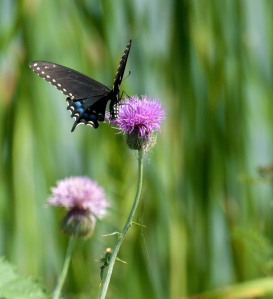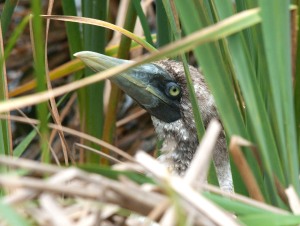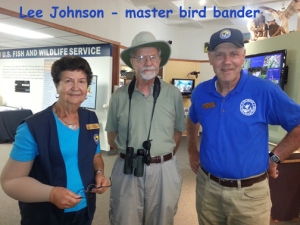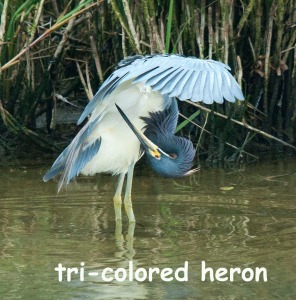Border Patrol briefing. A representative from the Border Patrol (BP) talked to volunteers for an hour and a half last week. We all had questions of course and did get a few answers. This is what he told us. Border crossings are down in our area near the Refuge. The border fences are working to channel illegals into small areas where they can be more easily intercepted. Tethered balloons, previously used for weather forecasting, can be seen every several miles along the border. The BP uses vehicles, boats, horses, bicycles, helicopters, drones, tethered balloons and aircraft. The BP officer told us they are concentrating on criminals that transfer drugs and money across the border. Using intelligence, they try to identify and capture high level cartel members. Every illegal captured is questioned and fingerprinted. If the illegal is new to the system, he/she is given a court date. He says they understand that 98% don’t show up. If they don’t appear, a deportation order is created, in absentia. However, almost every illegal goes back to their home country for holidays, funerals, Holy Week, Christmas, to see their family, etc. If these people enter the U.S. again and are captured, they are now identified and sent right back to their home country (no more court dates). Mexican deportees are passed across the border into Mexico. OTMs (other than Mexican) are flown back to their home country, usually El Salvador, Honduras, Nicaragua, Brazil and other South American countries. The U.S. pays for these flights. He says the U.S threatens to withhold the usual monetary assistance to countries if they don’t accept their own citizens back. This seems to work (if we really do this).
Three years ago, 254,000 illegals were detained in the Rio Grande Valley area. So far in 2015, about 50,000 have been caught. Estimates (guesses really) are that only about 50% of illegal border crossing attempts are detected and captured.

Power Outages and Storm Damage. We recently had a power outage for a few hours because a rotted power pole was being replaced next to the Visitor Center. It’s so humid here in the south Texas jungle and because it was our day off we sat in the VC for a couple of hours. The VC was being powered by a big portable generator. The Refuge tram had to be cancelled because the power company truck that was replacing the pole was blocking the tram access road. We also had a severe storm (lightning all over the valley) a few days ago that made national news. Many, many trees were blown over in 70 miles per hour winds, including a few within 25 feet from our motorhome. Another volunteer and I went out on the tram road and chain-sawed trees that had fallen across the road. We managed a couple of hours in the heat and probably only got half a mile into the refuge. The entire refuge had to be closed for two days.
 Great Birding at South Padre Island. We’ve had overcast, humid, rainy days here for the last several weeks. These conditions aren’t good for photography. The winds over South Padre Island (SPI) have almost continuously been blowing from south to north, helping the birds migrate over the gulf and encouraging them to fly over SPI and go hundreds of miles further north. We’ve persisted anyway and have had a couple of pretty good days.
Great Birding at South Padre Island. We’ve had overcast, humid, rainy days here for the last several weeks. These conditions aren’t good for photography. The winds over South Padre Island (SPI) have almost continuously been blowing from south to north, helping the birds migrate over the gulf and encouraging them to fly over SPI and go hundreds of miles further north. We’ve persisted anyway and have had a couple of pretty good days.
New birds for us last week and this week: Northern waterthrush, Acadian flycatcher, Ovenbird, red-eyed vireo, lilac-crowned parrot and red-lored parrot. A large parrot community lives at a public park in Brownsville. The waterthrush was a bird we thought we already had on our list but didn’t. The northern waterthrush and the Louisiana waterthrush look very much alike. There are several website references that help us to distinguish the two birds apart and we had to use many of them. The Acadian flycatcher is a difficult identification as well but we both took lots of pictures and checked several references. We’re 98% sure of the ID. Three other birders helped us identify the Acadian and it was there for an hour, flying around.
Actually, we saw another new bird that we dithered about putting on our list. A couple at the Convention Center told us they had seen a masked booby on the beach the previous day. Yes, it’s a bird. What do you know, the bird showed up at the pond by the South Padre Island convention center. The problem was that the bird was a juvenile and appeared either terribly tired or perhaps dying. We watched it make a tunnel in the reeds, probably to protect itself until it recovered. We counted it for our lists but felt badly for the bird. It looked very stressed.
All Creatures Great and Small. Every once in a while, we meet people at our Visitor Center who have interesting stories or are stories in themselves. An older man named Lee Johnson came in with his wife. He seemed like a knowledgeable birder and I chatted with him. It turns out he is way up on the list of people with huge bird lists within the ABA (American Birding Association) region. He has seen 780 birds in the limits of the U.S. and Canada. He’s been birding since the early 1940’s, has founded ornithology organizations and is a renowned bird-banding expert. He’s from Wisconsin. In the birding community, he’s famous. In response to an obvious question (what bird would you like to see now?) he said he wants to see the fieldfare, a European bird that is only accidental in North America. It is only seen rarely in North America. I heard about another man who has over 800 but that’s just rumor here. Seeing 780 birds in a lifetime of birding doesn’t sound like much but it really puts into perspective the achievement noted in the movie “The Big Year” when Sandy Komito saw 745 birds in just one year, a record that will probably never be broken.
Tony. Another man we met last week isn’t famous but should be. His name is Tony Villegas. He came to the Refuge with his daughter and sister-in-law. He’s 96 years old and full of energy. He was born next door in Pharr and still lives there. While the two women went for a short walk in the Refuge, Tony and I talked while I “took care of him.” He tried to join the Marines in the early 40’s but was too small. He accepted in the Army in mid-1941 and was in a training program when Pearl Harbor happened. He spent much of the war in North Africa and Italy, including Monte Casino, which had been bombed to pieces before he went there. He told me the story of one of his Army buddies who went to the Philippines, was captured and spent four years in a prison camp. He saw him after the war and didn’t recognize him. Tony has an incredible mind and a delightful personality. I told him he was a national treasure and thanked him for coming to see us.
I liked Tony’s little story about a chachalaca who was in a yard in back of his house. He and his neighbor sometimes fed them. A hawk flew down toward the chachalaca, intending to kill and eat it. The chachalaca zipped over the fence, ran between Tony’s legs and stayed there. He knew he had a friend.
Locally Famous Rio Grande Valley People. As we drive around the RGV, as we call it, we often have questions about what we see. We’ve decided, if we come back next year, we’ll start a project to research all the people for whom streets, highways, schools and even cities are named after. Early street name sightings include Cesar Chavez, who of course is famous as an advocate for farm worker’s rights. Raul Longoria is a street named after a local educator. As we passed by the little town of San Benito, I asked Arlyne who this saint was. She googled the history of San Benito, finding that this town was initially named after an early president of Mexico named Luis. Later they renamed it after a beloved local rancher named Benjamin. They agreed that he was virtually a saint, hence the name San Benito. That’s pretty cool. We’ve got dozens of names to go and even Google probably doesn’t have all the info. By the way, the local city of Weslaco, Texas is named after the W.E. Stewart Land Company. In 1919, four brothers purchased 320 acres from landowner W.E. Stewart to establish this new town.
The very small creature department. Arlyne and I have been overwhelmed by chiggers the last several days. These are nearly invisible little mites that drop onto your clothes and skin if you so much as brush against any vegetation here in Texas during the spring and summer. The bites don’t show up until the next day and it’s too late by then. The itching is, according to Google and me, is intense and unrelenting. We tried a few creams but I told the pharmacist in town that I wanted a medication so powerful it would give me a near-death experience. After a laugh, he recommended some creams that mostly work. We bought all three. I had the worst condition, with upwards of 50 bites. I told Arlyne to take a Magic Marker and connect the dots all over me to see what kind of image would show up. Probably a huge chigger. The nearly continuous rains we’ve had brought out the chigger population. We’re now World Headquarters. I told the Refuge manager I won’t go out in the refuge anymore without a Hazmat suit. Chiggers are smaller than the period at the end of this sentence.
Butterflies. The weather has finally warmed up and the promised butterflies are showing up. We have learned to recognize a few. I put butterfly bait on some special little logs that are hung from trees around the visitor center. We may not always see these little creatures but the bait keeps them in the area. They’re way tougher to photograph than birds. Butterflies have the most beautiful names and we’ve seen a few of the prettiest.
 Bordered patch and black swallowtail
Bordered patch and black swallowtail
Visitors from an Infamous City. A man and wife arrived at the Refuge on a trip from England. I made small talk with them and asked where they were from in England. He said “We’re from Narborough, have you heard of Narborough?” I told him no, I hadn’t. He said “It’s quite famous as the town where DNA was first used to solve a crime. Have you heard of Colin Pitchfork?” I said; wait a minute, wasn’t that a case many years ago when two girls were killed? He said (sadly) that Narborough was the place and that he had been living there in the 80’s, at the time of the murders. Colin Pitchfork was finally convicted of the crimes. He had persuaded another man to supply DNA in his place when the police asked hundreds of men to donate DNA samples. The other man bragged about what he had done in (where else) a pub. In the annals of crime, yes, Narborough is infamous.
Bird Pictures. Arlyne has turned out to be a very good bird photographer. She is adept at spotting birds and catching them in photos, many of them action shots. So I’m including photos from both of us. She has posted many of her bird pictures on her Facebook.
Whoops……..not a bird but great timing to see this guy walking through the surf on South Padre Island.
Thanks for checking in with us, Bob and Arlyne Draper












